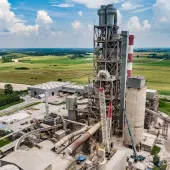Aggregate Industries launch ECOPlanet in the UK
Company introduces range of green cement that delivers more than a 30% reduction in carbon
AGGREGATE Industries have launched ECOPlanet, a range of green cement that delivers at least a 30% reduction in carbon compared with standard CEM I.
Launching in the UK for the first time, ECOPlanet uses a broad range of low-emission raw materials, such as fly ash, to create a low-carbon product that does not compromise on performance. Its low-carbon footprint is further enhanced by the decarbonizing of its production process through the use of alternative fuels.
ECOPlanet is the latest product range in Aggregate Industries’ suite of green building solutions and is the lowest CO2 footprint fly ash cement available in the UK. Other key benefits of ECOPlanet include its resistance to both sulphate attack and chloride ingress, and prevention against alkali-silica reaction. It also improves pumpability, placing and finishing – making it an ideal solution for high-durability requirements.
Dragan Maksimovic, chief executive officer of Aggregate Industries, said: ‘The launch of ECOPlanet expands on our existing low-carbon products, including ECOPact, the world’s broadest range of green concrete, and Super-Low Carbon, the first asphalt using biogenic material within the bitumen.
‘The product is driven by innovation and by our ambitions to build a net-zero future, and we’re delighted once again to be pushing the boundaries of low-carbon construction solutions.’
Steve Curley, managing director of cement at Aggregate Industries, said: ‘The launch of ECOPlanet represents yet another step forward in the transition towards a more sustainable construction industry. Its innovative formula and unique production process deliver at least 30% lower CO2, making it the first low-carbon cement for the precast segment available in the UK.
‘We look forward to working with our customers to provide yet another option to support our collective goal of achieving net zero emissions.’







